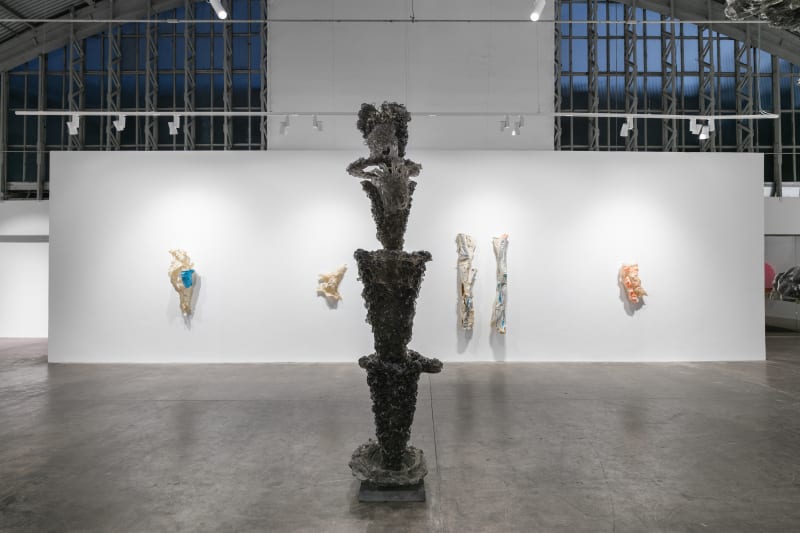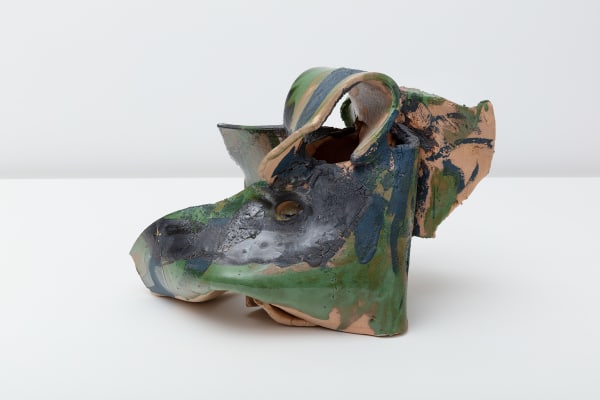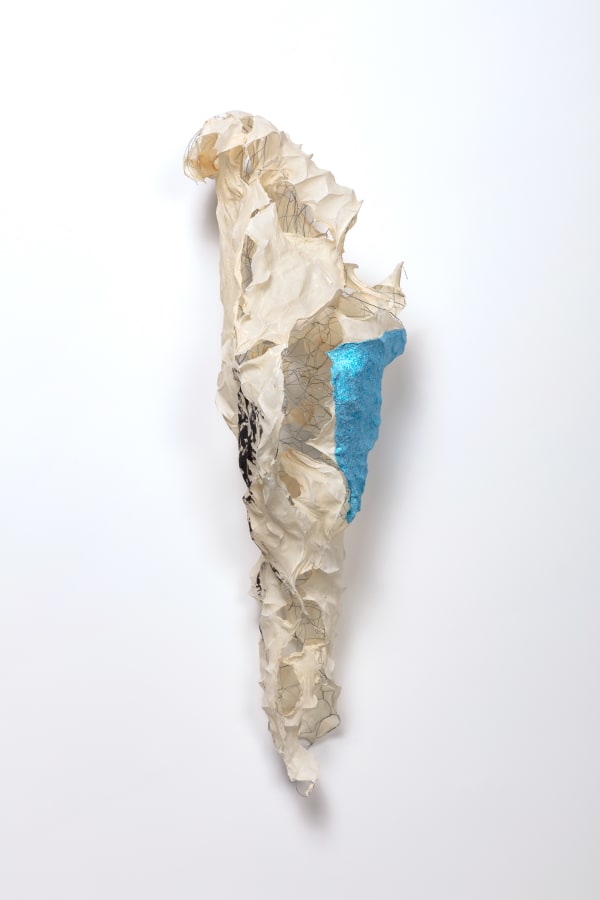Frozen Gestures Lynda Benglis
Past exhibition
Overview
More is more. – Lynda Benglis.
Mendes Wood DM is proud to present the first solo exhibition of the seminal American artist Lynda Benglis at its São Paulo gallery. Benglis has played an important role in contemporary art through her innovative use of materials and continued refusal to submit to aesthetic orthodoxies.
Benglis’s exhibition in São Paulo brings together sculptures in a variety of media from the past 13 years of her career. Drawn from different bodies of work, each group of sculptures reflects Benglis’s interest in material innovation and engagement with movement, light, space, form, and surface.
Art historian and critic Robert Pincus-Witten coined the term “the frozen gesture” to characterize Benglis’s art in his foundational 1974 article on the artist in Artforum. As a young artist working during the rise of Minimalism, Post-Minimalism, and Process art, Benglis recognized the phrase as a succinct and potent description of her work, one which she has repeated many times over the years. Yet in 1974, “the frozen gesture” took much of its meaning from its artistic context. It conjured Abstract Expressionism, opposed Minimalism, and assumed a theatricality Benglis embraced. With a career that now spans more than five decades, Benglis has transcended that original context through her ongoing explorations of new forms, materials, and ideas. Though gesture remains a fundamental component of her work, in her more recent sculpture “the frozen gesture” may sometimes be unfrozen, multiplied, or otherwise complicated.
The Mendes Wood DM exhibition includes Black Ice, a trio of totem-like stacks of irregular conical vessels. The scale of each form is striking. As they seem to tilt and teeter in a multi-jointed contrapposto, these works hover instead of towering over the viewer, calling to mind a strange, dark, seductive version of the Three Graces from classical Greece. Their rugose surfaces bubble, coil, and cross in constant motion. Earthy evocations of crawfish mounds allude to Benglis’s childhood in Lake Charles, Louisiana, combining with the convolutions of the human brain and the coral Benglis frequently saw while scuba diving. Black Ice refuses to be still in either form or surface.
The varied translucency of Black Ice’s black-pigmented polyurethane highlights an ongoing theme in Benglis’s sculpture: plays on the difference between surface and form. With cast polyurethane works like Black Ice, it is impossible to separate the “skin” of the sculpture from the meat of the “body” beneath. In place of this distinction, as light shines through the sculpture, the viewer witnesses constant shifts between materiality and its dissolution.
“Skin” is the word Benglis frequently returns to when she describes the paper sculptures she began making in 2011 and 2012. Ohkay Owingeh, one of Benglis’s earliest “paper pieces,” was made by stretching a skin of wet handmade paper over a chicken wire form, which was removed once the paper dried. After completing her first series of paper pieces in 2012, Benglis began to leave the original chicken wire support intact. In sculptures like Fern Cone, Benglis applied handmade paper to portions of the sculpture, exposing its chicken wire skeleton. Unlike the knots Benglis made in the 1970s, the later paper pieces are open forms that create space as they reveal their interiors.
In their lightness and papery buoyancy, many of the paper pieces seem to float or fly. The shape of Ohkay Owingeh, for example, seems to take flight as it hangs in place. Other paper pieces have shapes that suggest more subtle organic movements. The conjoined tubes of Angel’s Flight recall not only wings, but the quiet stirring of two cocoons, living forms in constant generative motion and transformation.
Benglis may often invoke nature in the shapes and titles of her paper pieces, but she also injects them with some glitz. Whether “sparkled” with glued glitter or covered in handmade sparkle paper (“cast sparkles,” as the artist likes to call it), the contrast between the bone-like tones of handmade paper and the reflective metallic hues of the sparkles points to Benglis’s interest in pairing the organic and the artificial. Silver Pairfeatures two frilly, plant-like stalks that look as if they are about to head to the disco. Combinations of natural and manmade elements have long been central to Benglis’s practice. The artist’s early latex paintings, for example, were made with natural latex rubber mixed with glaringly artificial fluorescent pigment. They recall both the natural flows of bodies of water and the rainbow sheen of the oil slicks that pollute them.
If the paper pieces seem to be airborne, Benglis’s ceramics are earthbound and deeply involved with the body—her body. Shunning traditional methods of working with clay that emphasize flawless silhouettes and immaculate surfaces, Benglis often works with extruded clay tubes or flat slabs. Her goal is not to achieve a perfectly refined surface, but to engage in a visceral exchange with the material. “When I do ceramics, I feel a need to kind of wrestle with the material and be integrated with the form and the surface. I can only tell you that the thinking in it is so fast. It’s a dance. I feel the clay; I am the clay, so to speak. I feel this in all my work, that I am the material and what I am doing is embracing it and allowing it to take form.” [1]
In the bent, folded, and torn forms of works like Choctaw and Apalachee, the results of this gestural wrestling are united with the application of multiple types of colored glazes—some matte, some glossy. Benglis’s glazes are a far cry from the finely speckled painted surfaces of some of her peers. They are instead fast, aggressive, and instinctive responses to the ceramic form, featuring crusty clots and jagged edges that play with and against the abrupt contortions of the clay planes. The final sculptures are both pictorial and spatial, an accumulation of “frozen gestures” marrying painterly abstraction with forms that defy any facile perceptual understanding.
Quoted in Life magazine in 1970, Benglis stated, “I realized that the idea of directing matter logically was absurd. Matter can and will take its own form.”[2] This early acknowledgement of the agency of her materials would direct Benglis’s work for decades to come. The artist welcomes uncertainty with full assurance because she collaborates with her materials instead of controlling them. In the process of each interaction with a new material, there is an openness that comes with maturity, an ability to allow in the sights, textures, and colors of her life, experience, and landscape as a part of the exchange.
Lynda Benglis (Louisiana, 1941) lives and works in Santa Fe.
Her work is included in numerous museums and public collections worldwide, including Centre Pompidou, Paris / Dallas Museum of Art, Texas / Jewish Museum, New York / Metropolitan Museum of Art, New York / Museum of Contemporary Art, Chicago, Illinois / Museum of Contemporary Art, Los Angeles, California / The Museum of Modern Art, New York / Serralves Museum, Porto / Smithsonian American Art Museum, Washington, D.C. / Solomon R. Guggenheim Museum, New York / Tate Modern, London / Whitney Museum of American Art, New York.
[1] Zwick, Tracy. “Dancing with Clay: An Interview with Lynda Benglis.” Art in America (21 January 2014).
[2] Bourdon, David. “Fling, Dribble, and Dip.” Life, 27 February 1970, p. 62.
Benglis’s exhibition in São Paulo brings together sculptures in a variety of media from the past 13 years of her career. Drawn from different bodies of work, each group of sculptures reflects Benglis’s interest in material innovation and engagement with movement, light, space, form, and surface.
Art historian and critic Robert Pincus-Witten coined the term “the frozen gesture” to characterize Benglis’s art in his foundational 1974 article on the artist in Artforum. As a young artist working during the rise of Minimalism, Post-Minimalism, and Process art, Benglis recognized the phrase as a succinct and potent description of her work, one which she has repeated many times over the years. Yet in 1974, “the frozen gesture” took much of its meaning from its artistic context. It conjured Abstract Expressionism, opposed Minimalism, and assumed a theatricality Benglis embraced. With a career that now spans more than five decades, Benglis has transcended that original context through her ongoing explorations of new forms, materials, and ideas. Though gesture remains a fundamental component of her work, in her more recent sculpture “the frozen gesture” may sometimes be unfrozen, multiplied, or otherwise complicated.
The Mendes Wood DM exhibition includes Black Ice, a trio of totem-like stacks of irregular conical vessels. The scale of each form is striking. As they seem to tilt and teeter in a multi-jointed contrapposto, these works hover instead of towering over the viewer, calling to mind a strange, dark, seductive version of the Three Graces from classical Greece. Their rugose surfaces bubble, coil, and cross in constant motion. Earthy evocations of crawfish mounds allude to Benglis’s childhood in Lake Charles, Louisiana, combining with the convolutions of the human brain and the coral Benglis frequently saw while scuba diving. Black Ice refuses to be still in either form or surface.
The varied translucency of Black Ice’s black-pigmented polyurethane highlights an ongoing theme in Benglis’s sculpture: plays on the difference between surface and form. With cast polyurethane works like Black Ice, it is impossible to separate the “skin” of the sculpture from the meat of the “body” beneath. In place of this distinction, as light shines through the sculpture, the viewer witnesses constant shifts between materiality and its dissolution.
“Skin” is the word Benglis frequently returns to when she describes the paper sculptures she began making in 2011 and 2012. Ohkay Owingeh, one of Benglis’s earliest “paper pieces,” was made by stretching a skin of wet handmade paper over a chicken wire form, which was removed once the paper dried. After completing her first series of paper pieces in 2012, Benglis began to leave the original chicken wire support intact. In sculptures like Fern Cone, Benglis applied handmade paper to portions of the sculpture, exposing its chicken wire skeleton. Unlike the knots Benglis made in the 1970s, the later paper pieces are open forms that create space as they reveal their interiors.
In their lightness and papery buoyancy, many of the paper pieces seem to float or fly. The shape of Ohkay Owingeh, for example, seems to take flight as it hangs in place. Other paper pieces have shapes that suggest more subtle organic movements. The conjoined tubes of Angel’s Flight recall not only wings, but the quiet stirring of two cocoons, living forms in constant generative motion and transformation.
Benglis may often invoke nature in the shapes and titles of her paper pieces, but she also injects them with some glitz. Whether “sparkled” with glued glitter or covered in handmade sparkle paper (“cast sparkles,” as the artist likes to call it), the contrast between the bone-like tones of handmade paper and the reflective metallic hues of the sparkles points to Benglis’s interest in pairing the organic and the artificial. Silver Pairfeatures two frilly, plant-like stalks that look as if they are about to head to the disco. Combinations of natural and manmade elements have long been central to Benglis’s practice. The artist’s early latex paintings, for example, were made with natural latex rubber mixed with glaringly artificial fluorescent pigment. They recall both the natural flows of bodies of water and the rainbow sheen of the oil slicks that pollute them.
If the paper pieces seem to be airborne, Benglis’s ceramics are earthbound and deeply involved with the body—her body. Shunning traditional methods of working with clay that emphasize flawless silhouettes and immaculate surfaces, Benglis often works with extruded clay tubes or flat slabs. Her goal is not to achieve a perfectly refined surface, but to engage in a visceral exchange with the material. “When I do ceramics, I feel a need to kind of wrestle with the material and be integrated with the form and the surface. I can only tell you that the thinking in it is so fast. It’s a dance. I feel the clay; I am the clay, so to speak. I feel this in all my work, that I am the material and what I am doing is embracing it and allowing it to take form.” [1]
In the bent, folded, and torn forms of works like Choctaw and Apalachee, the results of this gestural wrestling are united with the application of multiple types of colored glazes—some matte, some glossy. Benglis’s glazes are a far cry from the finely speckled painted surfaces of some of her peers. They are instead fast, aggressive, and instinctive responses to the ceramic form, featuring crusty clots and jagged edges that play with and against the abrupt contortions of the clay planes. The final sculptures are both pictorial and spatial, an accumulation of “frozen gestures” marrying painterly abstraction with forms that defy any facile perceptual understanding.
Quoted in Life magazine in 1970, Benglis stated, “I realized that the idea of directing matter logically was absurd. Matter can and will take its own form.”[2] This early acknowledgement of the agency of her materials would direct Benglis’s work for decades to come. The artist welcomes uncertainty with full assurance because she collaborates with her materials instead of controlling them. In the process of each interaction with a new material, there is an openness that comes with maturity, an ability to allow in the sights, textures, and colors of her life, experience, and landscape as a part of the exchange.
Lynda Benglis (Louisiana, 1941) lives and works in Santa Fe.
Her work is included in numerous museums and public collections worldwide, including Centre Pompidou, Paris / Dallas Museum of Art, Texas / Jewish Museum, New York / Metropolitan Museum of Art, New York / Museum of Contemporary Art, Chicago, Illinois / Museum of Contemporary Art, Los Angeles, California / The Museum of Modern Art, New York / Serralves Museum, Porto / Smithsonian American Art Museum, Washington, D.C. / Solomon R. Guggenheim Museum, New York / Tate Modern, London / Whitney Museum of American Art, New York.
[1] Zwick, Tracy. “Dancing with Clay: An Interview with Lynda Benglis.” Art in America (21 January 2014).
[2] Bourdon, David. “Fling, Dribble, and Dip.” Life, 27 February 1970, p. 62.
Works
Installation Views










